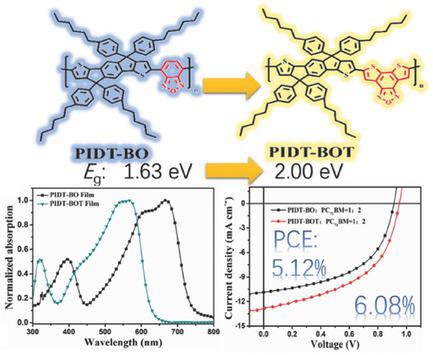当前位置:
X-MOL 学术
›
Macromol. Rapid Commun.
›
论文详情
Our official English website, www.x-mol.net, welcomes your feedback! (Note: you will need to create a separate account there.)
Fusing Benzo[c][1,2,5]oxadiazole Unit with Thiophene for Constructing Wide‐bandgap High‐performance IDT‐based Polymer Solar Cell Donor Material
Macromolecular Rapid Communications ( IF 4.6 ) Pub Date : 2018-02-13 , DOI: 10.1002/marc.201700782 Xin Song 1 , Meijie Fan 1 , Kaili Zhang 1 , Dakang Ding 1 , Weiye Chen 1 , Yonghai Li 2 , Liangmin Yu 3 , Mingliang Sun 1 , Renqiang Yang 2
Macromolecular Rapid Communications ( IF 4.6 ) Pub Date : 2018-02-13 , DOI: 10.1002/marc.201700782 Xin Song 1 , Meijie Fan 1 , Kaili Zhang 1 , Dakang Ding 1 , Weiye Chen 1 , Yonghai Li 2 , Liangmin Yu 3 , Mingliang Sun 1 , Renqiang Yang 2
Affiliation

|
Benzo[c][1,2,5]oxadiazole (BO) moiety is a strong electron‐withdrawing unit compared to benzo[c][1,2,5]thiadiazole (BT). It is usually introduced as an acceptor to construct narrow band‐gap donor‐acceptor (D‐A) materials. Herein, the π‐extended conjugated moiety dithieno[3′,2′:3,4″;2,3″:5,6]benzo[1,2‐c][1,2,5]oxadiazole (BOT) was adopted as the acceptor moiety to design D‐A polymers. Considering the more extended π‐conjugated molecular system of BOT compared to the BO unit, a narrower optical band‐gap is expected for BOT‐based IDT polymer (PIDT‐BOT). Unexpectedly, the UV‐vis absorption spectra of PIDT‐BOT films display a great hypochromatic shift of about 60 nm compared to a BO‐based analog (PIDT‐BO). The optical band‐gaps of the materials are broadened from 1.63 eV (PIDT‐BO) to 2.00 eV (PIDT‐BOT) accordingly. Although the range of external quantum efficiency (EQE) of PIDT‐BOT‐based polymer solar cell (PSC) devices is not as wide as for PIDT‐BO‐based devices, the EQE response intensities of the PIDT‐BOT based device are evidently high. As a result, PSC devices based on PIDT‐BOT reveal the best power conversion efficiency at 6.08%.
中文翻译:

将苯并[c] [1,2,5]恶二唑单元与噻吩融合以构建宽带隙高性能基于IDT的聚合物太阳能电池供体材料
与苯并[c] [1,2,5]噻二唑(BT)相比,苯并[c] [1,2,5]恶二唑(BO)部分是一个强大的吸电子单元。通常将其作为受体引入,以构建窄带隙供体-受体(D-A)材料。在此,π-延伸的共轭部分二噻吩并[3',2':3,4“; 2,3”:5,6]苯并[1,2-c] [1,2,5]恶二唑(BOT)为被用作受体部分来设计D‐A聚合物。考虑到与BO单元相比,BOT的π共轭分子体系更加扩展,因此基于BOT的IDT聚合物(PIDT-BOT)的光学带隙预计会更窄。出乎意料的是,与基于BO的类似物(PIDT-BO)相比,PIDT-BOT膜的UV-vis吸收光谱显示出约60 nm的大幅色移。材料的光学带隙相应地从1.63 eV(PIDT-BO)扩大到2.00 eV(PIDT-BOT)。尽管基于PIDT-BOT的聚合物太阳能电池(PSC)设备的外部量子效率(EQE)范围不如基于PIDT-BO的设备宽,但基于PIDT-BOT的设备的EQE响应强度显然很高。因此,基于PIDT-BOT的PSC器件显示出最佳的电源转换效率,为6.08%。
更新日期:2018-02-13
中文翻译:

将苯并[c] [1,2,5]恶二唑单元与噻吩融合以构建宽带隙高性能基于IDT的聚合物太阳能电池供体材料
与苯并[c] [1,2,5]噻二唑(BT)相比,苯并[c] [1,2,5]恶二唑(BO)部分是一个强大的吸电子单元。通常将其作为受体引入,以构建窄带隙供体-受体(D-A)材料。在此,π-延伸的共轭部分二噻吩并[3',2':3,4“; 2,3”:5,6]苯并[1,2-c] [1,2,5]恶二唑(BOT)为被用作受体部分来设计D‐A聚合物。考虑到与BO单元相比,BOT的π共轭分子体系更加扩展,因此基于BOT的IDT聚合物(PIDT-BOT)的光学带隙预计会更窄。出乎意料的是,与基于BO的类似物(PIDT-BO)相比,PIDT-BOT膜的UV-vis吸收光谱显示出约60 nm的大幅色移。材料的光学带隙相应地从1.63 eV(PIDT-BO)扩大到2.00 eV(PIDT-BOT)。尽管基于PIDT-BOT的聚合物太阳能电池(PSC)设备的外部量子效率(EQE)范围不如基于PIDT-BO的设备宽,但基于PIDT-BOT的设备的EQE响应强度显然很高。因此,基于PIDT-BOT的PSC器件显示出最佳的电源转换效率,为6.08%。


























 京公网安备 11010802027423号
京公网安备 11010802027423号